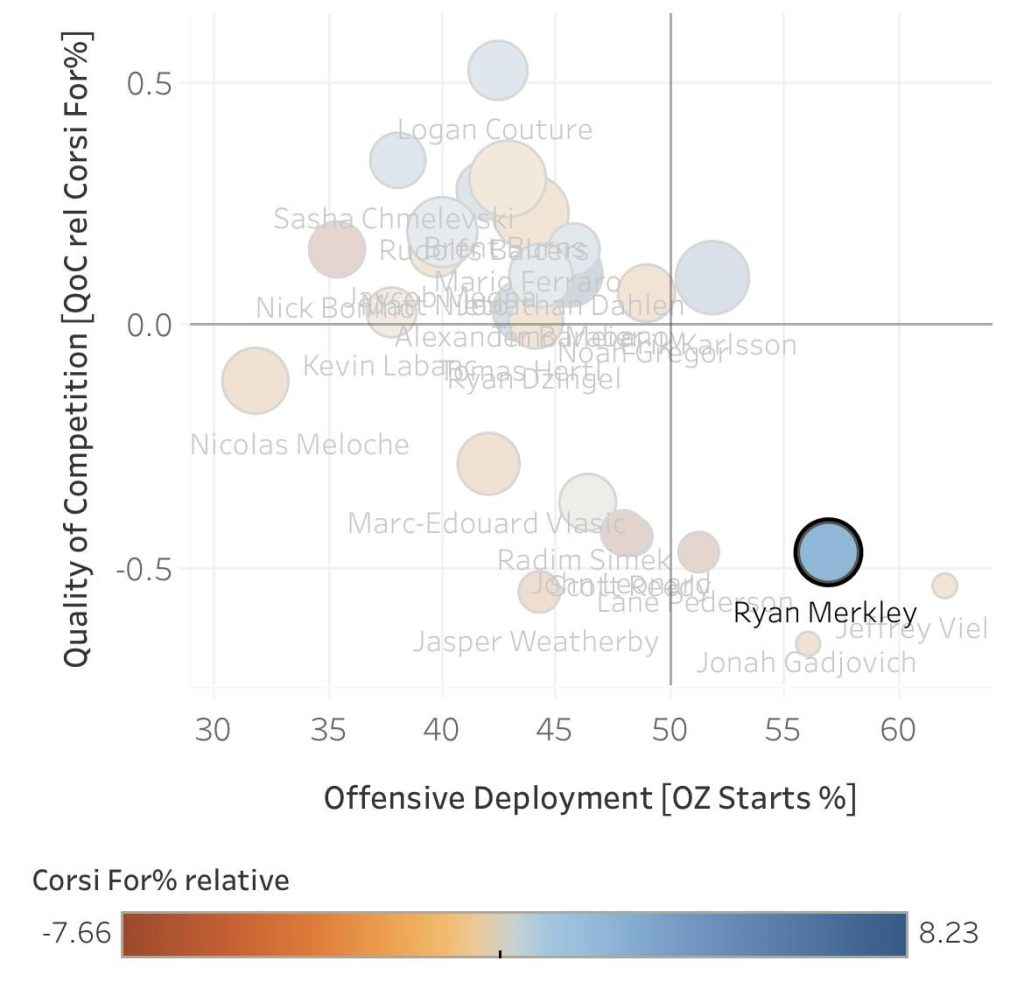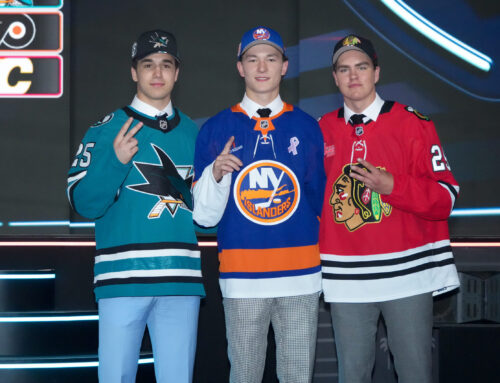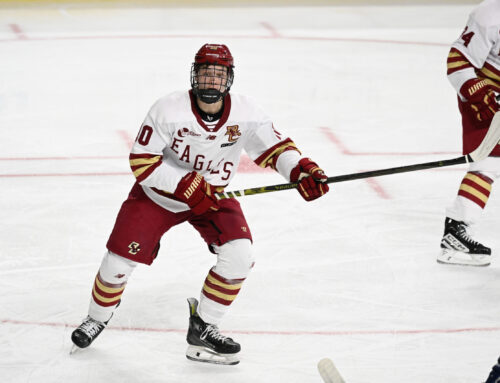Welcome back to The Journey, where we follow hockey prospects and their paths to the NHL, providing fantasy predictions and analysis along the way. This week, we'll take a look at three young defenceman from the 2018 draft who are on the verge of establishing themselves as emerging stars on the back end.
One has been traded, another signed to a three-year contract, and the last has seen a major obstacle to playing time removed via trade. All three are intriguing in fantasy because they offer excellent scoring upside at a modest price tag. We are far enough out now from the 2018 draft that the hype on these guys has largely died down and fantasy managers, spoiled by instant blue line stars like Cale Makar and Moritz Seider, are generally feeling impatient with their development. Now is the time to buy low if you can afford to wait another couple seasons.
Smith's fantasy value got a much-needed boost with his trade to the Penguins for John Merino. Once one of the most hyped defensive prospects in the game, Smith seemingly got lost in New Jersey's shuffle of offensively inclined defencemen over the past two years while producing 43 points in his first 114 NHL games.
A 31-point pace is actually decent for a young player but I think that fantasy managers expected more—given his astounding 201 points in 172 WHL games—and also worried about his role in the Devils organization longer term: with Dougie Hamilton being the clear number one, Damon Severson sucking up power play time, and studs Luke Hughes and Simon Nemec on the way, it was not clear where Smith would fit moving forward.
Those two factors have largely obscured the fact that Smith has actually performed quite well in his first two NHL seasons. He jumped directly from junior to the NHL in his Draft+3 year, which is not easy to do, and has managed to hold his own playing fairly big minutes, especially for a smaller, offensively minded defenceman. There was a noticeable dip, however, in both ice time and play driving in 2021-22 versus his rookie campaign. He averaged about two and a half fewer minutes and was less effective with the puck despite receiving similar sheltered deployment both years.
It is important to remember that Smith was primarily paired with Severson and P.K. Subban during his time in New Jersey, both of whom play a similar rushing, offensive style to him and aren't necessarily defensive anchors. Although Kris Letang will now rule the roost in Pittsburgh until he is 40 and new acquisition Jeff Petry also has a deft offensive touch, both are firmly in their mid-30s and will inevitably slow in the coming years right as Smith hits his stride. He will hit his 200-game Breakout Threshold right at the start of 2023-24 assuming he plays the full slate this year. Plus he may partner with Petry or defensive stalwart Marcus Pettersson, Marino's former running mate, either of whom would allow him more freedom to play his natural, risk-taking game.
Unlike in youthful New Jersey, the Penguins' prospect cupboards are all but bare, meaning Smith really only has Pierre-Oliver Joseph to contend with longer term. Joseph is a talented player but has never been a prolific scorer, even in junior. Once Smith adjusts to his new locale, look for his numbers to rise slowly but steadily. Now is the time to inquire about him because his value will likely never be lower.
For a more detailed analysis of Smith's first couple years in the league and what to expect from him moving forward, check out Alex Wyatt's article in the Dobber Prospects' column, The Century Mark.
What do fantasy managers have in Boqvist? He is part of the same 2018 draft class as Smith and has produced at a comparable rate (mid-30s) over a similar number of games. He is difficult to roster at the moment because he doesn't score consistently or contribute much besides points, but he has certainly flashed high-end ability of late.
Boqvist's speed, shot, and anticipation stand out in particular as significant assets. The offence will flow more steadily for him as he adjusts to this level and sees more ice time at both even strength and with the man advantage. This coming season, he will need to stay healthy and tighten up his defensive and transition games, including passing the puck out of the defensive zone more often instead of always carrying it out himself.
Although Zach Werenski owns the Columbus power play indefinitely, Jake Bean is lurking, and the Jackets just drafted two more high-powered offensive studs in David Jiricek and Denton Mateychuk, Boqvist still seems to have a future on this team. Columbus recently expressed their faith in him by signing him to a three-year bridge deal.
Boqvist has a very similar development curve to Vegas star Shea Theodore, who broke into 50+ territory in his fifth season shortly after reaching his 200-game BT. If Boqvist follows a similar trajectory, a best-case scenario for his fantasy owners, his breakout will arrive in 2023-24, just in time to firmly establish himself before the arrival of Jiricek and Mateychuk.
Now that Brent Burns and his 26:00 minutes per night have moved on to Carolina, Merkley should have more room to operate on the back end in San Jose. Although he posted 147 points in 123 games in junior, he has been incredibly slow to translate his sublime offensive instincts to the majors. Given Merkley's well-documented attitude issues in his OHL days, which caused him to slip into the last third of the 2018 draft, the majority of fantasy owners have lost patience with the mercurial blue liner by now.
On the bright side, in addition to no longer being blocked by Burns, Merkley finally showed flashes of high-end production in the AHL last year. He ended up with 19 points in 30 AHL games in 2020-21, including ten on the power play, but the majority of those came during a near point-per-game stretch before being called up to the Sharks again.
While up with the Sharks for 39 games, Merkley was paired primarily with the steady Marc-Edouard Vlasic. Although the youngster played limited minutes and was very sheltered, playing with Vlasic seemed to agree with him as he posted positive play-driving metrics relative to his teammates.

Merkley only scored six points during his rookie campaign but the stage seems set for him to make a bigger impact on the scoresheet for the Sharks in 2022-23. For one thing, he should receive more than the 15 minutes at even strength and 34% of available power play time he saw last year, and his creativity will have room to shine with that extra space on the man advantage. He will still have to contend with Erik Karlsson but the Swede is often injured, meaning Merkley may have a chance to feature on PP1 at times this year alongside Tomas Hertl, Logan Couture, Timo Meier, and (hopefully) William Eklund. The Sharks are past due for a proper rebuild but can still boast solid skill at the top of the lineup.
Of the three young, dynamic D-men featured here, Merkley is likely the cheapest to acquire in fantasy. If he can maintain the scoring momentum from his successful AHL stretch last year and capitalize when Karlsson inevitably misses time, he may also be facing the best opportunity of the three. Keep in mind, though: he is almost 100 NHL games behind Smith and Boqvist, so he will require a longer runway to show his actual upside. Look for him to post modest totals this year (say, in the 20s) and slowly build on that in the coming years as he attempts to reach his 50+ point ceiling.
Thanks for reading! Follow me on Twitter @beegare for more prospect content and fantasy hockey analysis.




 ANA
ANA CAR
CAR TOR
TOR VAN
VAN PIT
PIT MIN
MIN S.J
S.J BUF
BUF
